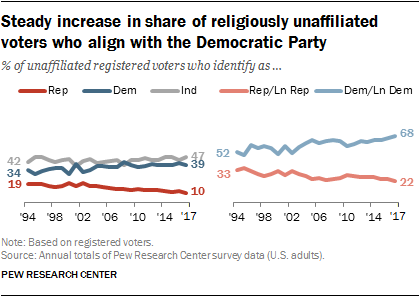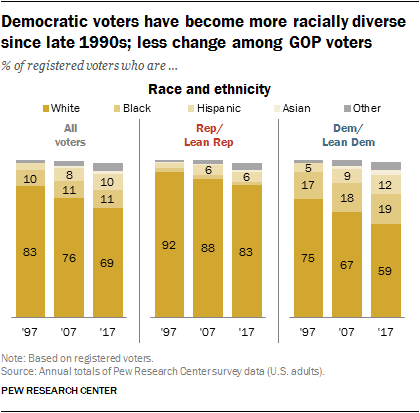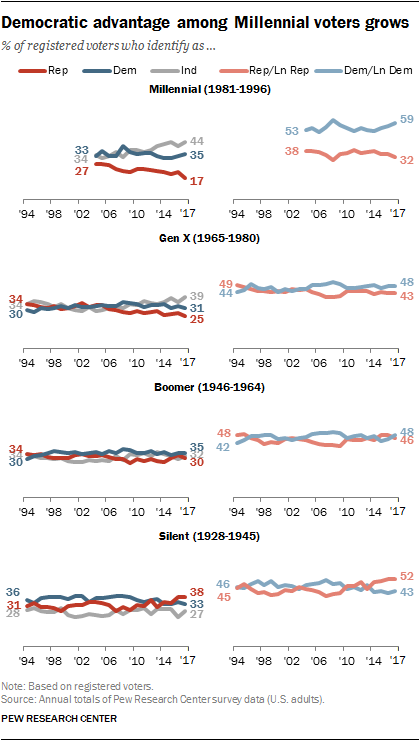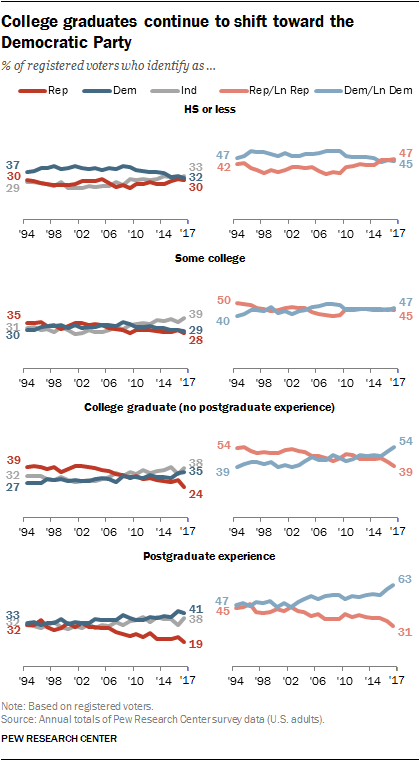(RNS) — Republicans have a lot to worry about in this midterm election year, strapped as they are to a deeply unpopular president and facing a possible “blue wave” at the polls in November.
The Pew Research Center recently released a report on party identification based on more than 10,000 interviews with registered voters in 2017, and found that 50 percent now identify as or “lean” toward the Democratic Party — the first time since just after President Obama’s election that Democrats have crossed that magical 50 percent barrier. This compares to 42 percent who identify as or lean Republican.
But that short-term situation is not the worst news the report contains for the Republican Party. The long-term outlook for the GOP is alarming based on four major demographic trends that do not favor Republicans.
1. Republicans do well with religious voters, but the nation is becoming less religious.

Religiously unaffiliated Americans (nones) have aligned themselves in large numbers with the Democratic Party. Source: Pew Research Center
Two things are going on here. The first is that the so-called nones — the religiously unaffiliated — are growing as a share of the voting population. In 1997, says Pew, nones were only 8 percent of the electorate. Now they’re 24 percent, triple their numbers of two decades ago. Meanwhile, Republicans’ core audience of white Protestants is shrinking as a share of the overall population.
The second is that the nones’ inclination toward the Democratic Party has become more pronounced over time and is now more than a two-thirds majority. “In 1994, about half (52 percent) of religiously unaffiliated voters leaned toward or identified with the Democratic Party,” according to Pew. “Today nearly seven-in-ten (68 percent) do so.”
Whether these nones will in fact vote is another story. In the 2016 election, when they made up 21 percent of the potential electorate, they represented only 16 percent of Americans who voted. This very diverse population is difficult to unify into a voting bloc, say experts. So if there’s a silver lining for the GOP, it’s that nones have yet to make their full power felt at the polls.
2. Republicans aren’t keeping pace with the nation’s growing racial diversity.

Racial diversity by political party, 1997 to 2017. Source: Pew Research Center
In 1997, 83 percent of American voters were white. Twenty years later, it was 69 percent.
What’s more, the nation is predicted to become “minority-majority” sooner rather than later. In 2060, whites are projected to be less than half of the U.S. population.
The population as a whole is not the same as the pool of registered voters, which tends to be a little less racially diverse, but the basic trend line is clear: America gets a little more diverse with every passing year.
Both parties have also become less white over time, but Republicans’ inroads with voters of color have been unimpressive. The GOP is still 83 percent white, while the Democratic Party is 59 percent white.
In other words, the GOP’s racial diversity mirrors the electorate’s … of 20 years ago.
3. Republicans aren’t getting any younger.

Since 1994, the only age group where Republicans have gained ground is among the elderly. Source: Pew Research Center
Republicans should be concerned that millennials are showing almost a 2-to-1 preference for the Democratic Party: 59 percent versus the 32 percent who prefer the GOP. The gap is particularly pronounced among millennial women, 70 percent of whom now identify as or lean Democratic.
People tend to get more politically conservative as they get older, though, so how can we know that this is a genuine “cohort effect” and not just an age effect that pertains to millennials right now because they’re young?
Looking at Pew’s longitudinal data from 1994 may call into question the old adage that people inevitably get more conservative as they age. The only generation that is more Republican now than it was in 1994 is the Silent Generation (born before the end of World War II). Baby boomers, Gen Xers and millennials have all moved away from the GOP, millennials rather dramatically so.
The effects of this are far-reaching. To be blunt, members of the Silent Generation are dying every day. The fact that the GOP has failed to retain the loyalty of any younger generation does not bode well for the party’s long-term future.
4. College-educated voters are turning to the Democratic Party.

Fifty-four percent of college graduates now vote or lean Democratic and 39 percent vote or lean Republican, the exact reverse of the 1994 statistics. Source: Pew Research Center
It used to be a truism that the Democrats were the party of the working class and of organized labor, whereas the GOP had pull with the college-educated. That’s changing. As Pew puts it:
In 1994, 39% of those with a four-year college degree (no postgraduate experience) identified with or leaned toward the Democratic Party and 54% associated with the Republican Party. In 2017, those figures were exactly reversed.
The GOP’s appeal has increased among voters with only a high school education, especially white ones.
The problem for Republicans is that Americans with a college education are growing as a share of the population: According to the U.S. Census Bureau, the ranks of the college-educated have risen slowly but steadily in recent years, from 28 percent in 2006 to 30 percent in 2010 and 33.4 percent in 2016.
In general, then, Republicans are succeeding with older white Christian voters who have less than a college education. The problem for them is that these voters are fast becoming thin on the ground.

4 reasons Republicans should be hella worried, and not just because of the midterms
Republicans still appeal to older white Christian voters who have less than a college education, says a new Pew study. The problem for the GOP is that these voters are fast becoming thin on the ground.
(RNS) — Republicans have a lot to worry about in this midterm election year, strapped as they are to a deeply unpopular president and facing a possible “blue wave” at the polls in November.
The Pew Research Center recently released a report on party identification based on more than 10,000 interviews with registered voters in 2017, and found that 50 percent now identify as or “lean” toward the Democratic Party — the first time since just after President Obama’s election that Democrats have crossed that magical 50 percent barrier. This compares to 42 percent who identify as or lean Republican.
But that short-term situation is not the worst news the report contains for the Republican Party. The long-term outlook for the GOP is alarming based on four major demographic trends that do not favor Republicans.
1. Republicans do well with religious voters, but the nation is becoming less religious.
Religiously unaffiliated Americans (nones) have aligned themselves in large numbers with the Democratic Party. Source: Pew Research Center
Two things are going on here. The first is that the so-called nones — the religiously unaffiliated — are growing as a share of the voting population. In 1997, says Pew, nones were only 8 percent of the electorate. Now they’re 24 percent, triple their numbers of two decades ago. Meanwhile, Republicans’ core audience of white Protestants is shrinking as a share of the overall population.
The second is that the nones’ inclination toward the Democratic Party has become more pronounced over time and is now more than a two-thirds majority. “In 1994, about half (52 percent) of religiously unaffiliated voters leaned toward or identified with the Democratic Party,” according to Pew. “Today nearly seven-in-ten (68 percent) do so.”
Whether these nones will in fact vote is another story. In the 2016 election, when they made up 21 percent of the potential electorate, they represented only 16 percent of Americans who voted. This very diverse population is difficult to unify into a voting bloc, say experts. So if there’s a silver lining for the GOP, it’s that nones have yet to make their full power felt at the polls.
2. Republicans aren’t keeping pace with the nation’s growing racial diversity.
Racial diversity by political party, 1997 to 2017. Source: Pew Research Center
In 1997, 83 percent of American voters were white. Twenty years later, it was 69 percent.
What’s more, the nation is predicted to become “minority-majority” sooner rather than later. In 2060, whites are projected to be less than half of the U.S. population.
The population as a whole is not the same as the pool of registered voters, which tends to be a little less racially diverse, but the basic trend line is clear: America gets a little more diverse with every passing year.
Both parties have also become less white over time, but Republicans’ inroads with voters of color have been unimpressive. The GOP is still 83 percent white, while the Democratic Party is 59 percent white.
In other words, the GOP’s racial diversity mirrors the electorate’s … of 20 years ago.
3. Republicans aren’t getting any younger.
Since 1994, the only age group where Republicans have gained ground is among the elderly. Source: Pew Research Center
Republicans should be concerned that millennials are showing almost a 2-to-1 preference for the Democratic Party: 59 percent versus the 32 percent who prefer the GOP. The gap is particularly pronounced among millennial women, 70 percent of whom now identify as or lean Democratic.
People tend to get more politically conservative as they get older, though, so how can we know that this is a genuine “cohort effect” and not just an age effect that pertains to millennials right now because they’re young?
Looking at Pew’s longitudinal data from 1994 may call into question the old adage that people inevitably get more conservative as they age. The only generation that is more Republican now than it was in 1994 is the Silent Generation (born before the end of World War II). Baby boomers, Gen Xers and millennials have all moved away from the GOP, millennials rather dramatically so.
The effects of this are far-reaching. To be blunt, members of the Silent Generation are dying every day. The fact that the GOP has failed to retain the loyalty of any younger generation does not bode well for the party’s long-term future.
4. College-educated voters are turning to the Democratic Party.
Fifty-four percent of college graduates now vote or lean Democratic and 39 percent vote or lean Republican, the exact reverse of the 1994 statistics. Source: Pew Research Center
It used to be a truism that the Democrats were the party of the working class and of organized labor, whereas the GOP had pull with the college-educated. That’s changing. As Pew puts it:
The GOP’s appeal has increased among voters with only a high school education, especially white ones.
The problem for Republicans is that Americans with a college education are growing as a share of the population: According to the U.S. Census Bureau, the ranks of the college-educated have risen slowly but steadily in recent years, from 28 percent in 2006 to 30 percent in 2010 and 33.4 percent in 2016.
In general, then, Republicans are succeeding with older white Christian voters who have less than a college education. The problem for them is that these voters are fast becoming thin on the ground.
Donate to Support Independent Journalism!